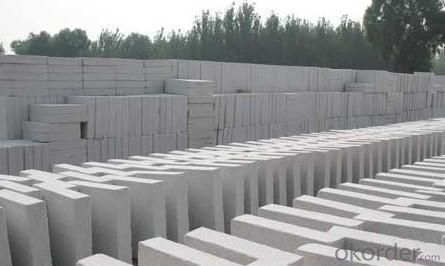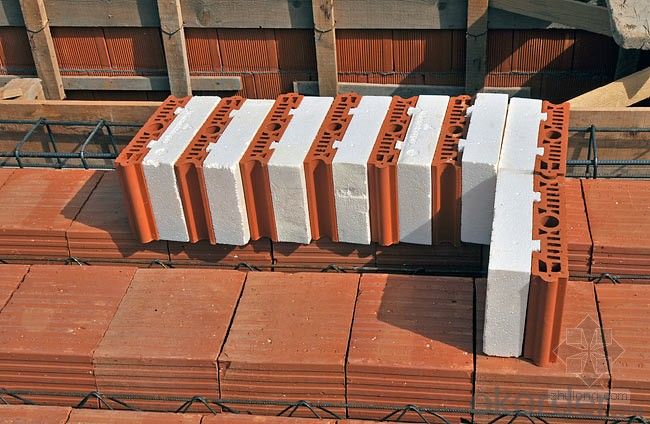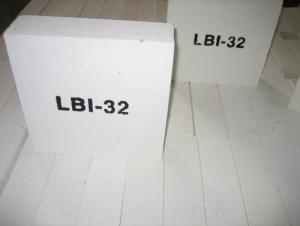Refractory Mullite Insulating Refractory Brick JM 28
- Loading Port:
- Shanghai
- Payment Terms:
- TT OR LC
- Min Order Qty:
- 20 m.t.
- Supply Capability:
- 20 m.t./month
OKorder Service Pledge
OKorder Financial Service
You Might Also Like
General Information
CMAX insulating firebricks are classified under temperature between 1300℃ to 1700℃, manufactured from high purity alumina clay.
1. Lower content of iron, alkaline and impurities, good high temperature properties.
2. Homogeneous structure, light weight, energy saving because lower heat storage in the furnace during cooling cycles.
3. High strength, good thermal shock resistance under high temperature.
4. Precise sizes due to grinding and shaping after sintering, which meets the requirement of construction.
5. Max service temp: Up to 1730C (3160F)
Feature
Light weight and low thermal conductivity
Low heat storage
Low iron and impurities
High thermal shock resistance
Application of Insulating brick
Metallurgical Industry: blast furnace, hot blast furnace, heating furnace, etc..
Petrochemical Industry: ethylene cracking furnace, hydrogen furnace, the main furnace, heating furnace, etc..
Ceramic industry: roller kiln, kiln, etc..
Glass industry: glass furnace regenerator, etc.
Carbon industry: carbon furnace, etc..
Aluminum electrolysis industry: aluminum reduction cell, etc.
Other industries: tunnel kiln, shuttle kiln, etc.
Advantages of heat insulation brick
Low thermal conductivity: many air holes will bring good thermal insulation effect, energy saving.
High crushing strength: high crushing strength, volume stability.
Low heat storage: small heat storage, absorb more heat, energy-saving effect is obvious.
Technical Data
ITEM | GJM30 | GJM28 | GJM26 | GJM23 |
Classification Temperature, ℉/℃ | 3000/1650 | 2800/1540 | 2600/1430 | 2300/1260 |
Bulk Density,g/cm³ | ≤1.0 | ≤0.9 | ≤0.8 | ≥0.5 |
Reheating Linear Change, % | ≤0.9 (1550℃,12 h) | ≤0.8 (1510℃,12 h) | ≤0.7 (1410℃,12 h) | ≤0.5 (1230℃,12 h) |
Al2O3 Content, % | ≥75 | ≥65 | ≥55 | ≥45 |
Fe2O3 Content, % | ≤0.5 | ≤0.6 | ≤0.7 | ≤1.0 |
Thermal Conductivity: | ||||
800℃, w/m.k | ≤0.39 | ≤0.37 | ≤0.35 | ≤0.18 |
1000℃, w/m.k | ≤0.43 | ≤0.41 | ≤0.39 | ≤0.20 |
1200℃, w/m.k | ≤0.48 | ≤0.46 | ≤0.43 | --- |
Insulating brick


Common problem solution
1. What products do you have?
We have all kinds of refractory bricks, refractory casting materials, mortar, cement, ceramic fiber products, etc..
Or you can browse our products to choose what you need.
2. How to control product quality?
With strict quality control system throughout the material selection and production process, we have the quality of refractory materials and ceramic fiber products to meet customer requirements.
From the selection of raw materials, the quality of our control to start. The quality of the raw materials required for each batch of products in the use of the front line test. In the production process, through the quality control of workers, and then to each piece of classification, and through quality supervision and inspection.
3. Could you give me a brief introduction to the application of your product?
My Company is mainly engaged in steel, cement, glass, ceramics, petrochemical, electric power and other industries.
4. If I need you, what kind of information do you need?
In order to select the right products, we will provide us with information, such as the United States, technical data, order quantity, product applications, etc..
If you have any questions, please contact us.
- Q:Can insulating fire bricks be used in high-temperature insulation boards?
- Yes, insulating fire bricks can be used in high-temperature insulation boards. Insulating fire bricks are designed to withstand high temperatures and provide excellent thermal insulation. They can be easily incorporated into insulation boards to enhance their insulating properties and increase their resistance to heat.
- Q:Can insulating fire bricks be used in the construction of heat storage units?
- Yes, insulating fire bricks can be used in the construction of heat storage units. These bricks are designed to have excellent thermal insulation properties, which allow them to retain and store heat effectively. Using insulating fire bricks in heat storage units helps to minimize heat loss and maintain a consistent temperature, making them suitable for applications where heat storage is required, such as in residential or commercial heating systems.
- Q:Can insulating fire bricks be used for insulation in ovens and kilns?
- Insulating fire bricks are indeed suitable for insulation in ovens and kilns. These bricks are specially designed to withstand high temperatures and offer exceptional thermal insulation. They are composed of lightweight materials such as clay and other refractory substances with low thermal conductivity. Consequently, they possess the ability to effectively retain heat and prevent its escape, making them an ideal choice for ovens and kilns where heat retention is of utmost importance. Furthermore, insulating fire bricks possess resistance against thermal shock, enabling them to endure rapid temperature changes without cracking or breaking. Ultimately, insulating fire bricks guarantee efficient heat distribution and energy conservation, making them a reliable option for insulating ovens and kilns.
- Q:Can insulating fire bricks be used in waste incineration plants?
- Yes, insulating fire bricks can be used in waste incineration plants. Insulating fire bricks are designed to withstand high temperatures, making them suitable for use in the extremely hot environment of waste incineration plants. These bricks are made from lightweight materials that have excellent thermal insulation properties, which helps to reduce heat loss and improve energy efficiency in the incineration process. Additionally, insulating fire bricks have good resistance to chemical and thermal shock, which is important in waste incineration plants where various types of waste materials are burned. Overall, the use of insulating fire bricks in waste incineration plants can contribute to better insulation, higher energy efficiency, and improved performance of the incineration process.
- Q:Do insulating fire bricks have a low thermal expansion rate?
- Yes, insulating fire bricks generally have a low thermal expansion rate. These bricks are designed to withstand high temperatures and thermal shocks, and one of their key properties is their ability to maintain their shape and dimensions under extreme heat conditions. Insulating fire bricks are made from materials that have a low coefficient of thermal expansion, meaning they expand and contract minimally when exposed to changes in temperature. This low thermal expansion rate ensures that the bricks remain stable and do not crack or break due to thermal stress. Additionally, the low thermal expansion rate of insulating fire bricks allows for better insulation performance, as it minimizes the gaps that can form between the bricks when they expand and contract, reducing heat loss and increasing energy efficiency.
- Q:Can insulating fire bricks be used in the construction of combustion chambers?
- The use of insulating fire bricks in combustion chambers is highly recommended. These bricks are created using lightweight, porous materials that possess exceptional thermal insulation capabilities. As a result, they are extremely suitable for high-temperature applications like combustion chambers, where their insulation aids in the containment and regulation of heat generated during the combustion process. The heat transfer resistance of insulating fire bricks is notably high, enabling them to effectively retain heat within the combustion chamber. This, in turn, enhances combustion process efficiency by minimizing heat loss to the surrounding environment. Moreover, these bricks' insulating properties help prevent the outer walls of the combustion chamber from overheating, thereby reducing the risk of structural damage. Furthermore, insulating fire bricks are specifically designed to endure elevated temperatures, rendering them highly durable and resilient. This is particularly crucial in combustion chambers, where intense heat and varying temperatures are commonplace. Their ability to withstand thermal shock and thermal cycling makes them a dependable choice for this purpose. To summarize, insulating fire bricks are an exceptional option for constructing combustion chambers due to their thermal insulation properties, heat retention ability, and resistance to high temperatures. They significantly contribute to the overall efficiency and safety of the combustion process, making them an invaluable component in combustion chamber construction.
- Q:Can insulating fire bricks be used in DIY projects?
- Yes, insulating fire bricks can be used in DIY projects. They are commonly used in various DIY applications such as constructing fire pits, ovens, kilns, and for lining chimneys. These bricks have excellent insulation properties, can withstand high temperatures, and are easy to work with, making them ideal for DIY projects requiring heat resistance.
- Q:Can insulating fire bricks be used in tundish linings?
- Insulating fire bricks can indeed be utilized in tundish linings. Comprised of lightweight refractory materials, these bricks boast exceptional insulation properties. Given that tundish linings are typically subjected to elevated temperatures and thermal shocks, which can prompt swift deterioration, incorporating insulating fire bricks can effectively shield the tundish lining from excessive heat and thermal stresses. These bricks exhibit low thermal conductivity, thereby minimizing heat loss and maintaining a constant temperature within the tundish. Moreover, insulating fire bricks possess commendable mechanical strength, rendering them capable of enduring the mechanical stresses commonly encountered during tundish operations. In essence, the utilization of insulating fire bricks in tundish linings can enhance thermal efficiency, curtail energy consumption, and prolong the tundish's lifespan.
- Q:How do insulating fire bricks affect the overall moisture control of a structure?
- Insulating fire bricks play a crucial role in moisture control in a structure. These bricks are made from materials with low thermal conductivity, such as ceramic fibers or refractory materials, which enable them to efficiently insulate against heat transfer. This insulation property not only helps in reducing heat loss or gain, but it also has a significant impact on moisture control. Due to their low thermal conductivity, insulating fire bricks act as a barrier to prevent the transfer of heat and moisture between the interior and exterior of a structure. This barrier helps maintain a stable and controlled environment within the building, minimizing the chances of condensation and moisture build-up. In regions with high humidity levels or in buildings where moisture infiltration is a concern, insulating fire bricks can help prevent the accumulation of moisture on the interior surfaces. Moisture infiltration can lead to various issues such as mold growth, corrosion, and deterioration of building materials. However, by effectively insulating the structure, these bricks reduce the risk of condensation forming on the surfaces, thus minimizing the potential for moisture-related problems. Furthermore, insulating fire bricks also have a high resistance to water absorption. This characteristic makes them less susceptible to moisture damage and ensures that they do not contribute to moisture problems within the structure. Their resistance to water absorption also helps in maintaining the integrity and longevity of the bricks themselves, as excessive moisture can lead to cracking, spalling, or degradation of the material. In summary, insulating fire bricks positively impact the overall moisture control of a structure by providing effective insulation against heat transfer and minimizing the potential for condensation and moisture accumulation. By acting as a barrier and resisting water absorption, these bricks contribute to a stable and controlled indoor environment while protecting the building materials from moisture-related damage.
- Q:Are insulating fire bricks suitable for use in the construction of incinerators?
- Yes, insulating fire bricks are suitable for use in the construction of incinerators. Insulating fire bricks have excellent thermal insulation properties, allowing them to withstand high temperatures and efficiently retain heat. This makes them ideal for lining the walls and floors of incinerators, as they help to contain and direct heat, ensuring proper combustion while reducing heat loss. Additionally, insulating fire bricks are resistant to chemical attacks and can withstand the corrosive environment found in incinerators, making them a reliable choice for this application.
1. Manufacturer Overview |
|
|---|---|
| Location | |
| Year Established | |
| Annual Output Value | |
| Main Markets | |
| Company Certifications | |
2. Manufacturer Certificates |
|
|---|---|
| a) Certification Name | |
| Range | |
| Reference | |
| Validity Period | |
3. Manufacturer Capability |
|
|---|---|
| a)Trade Capacity | |
| Nearest Port | |
| Export Percentage | |
| No.of Employees in Trade Department | |
| Language Spoken: | |
| b)Factory Information | |
| Factory Size: | |
| No. of Production Lines | |
| Contract Manufacturing | |
| Product Price Range | |
Send your message to us
Refractory Mullite Insulating Refractory Brick JM 28
- Loading Port:
- Shanghai
- Payment Terms:
- TT OR LC
- Min Order Qty:
- 20 m.t.
- Supply Capability:
- 20 m.t./month
OKorder Service Pledge
OKorder Financial Service
Similar products
New products
Hot products
Related keywords




























